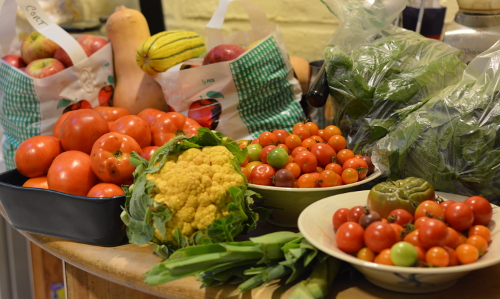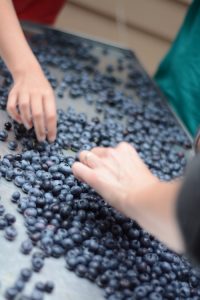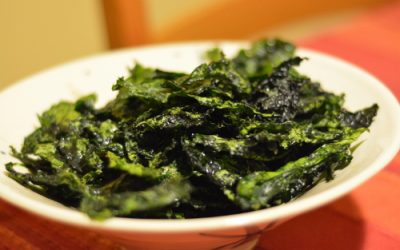
Today’s Wayland Farmers Market haul, complimented with homegrown tomatoes saved from the first frosts.
(To read the older posts in this blog, click here.)
All the folks in my household enjoyed the Omnivore’s Delight Challenge. Turns out we didn’t have to change our eating habits much – only our shopping habits. Still it was an interesting and inspiring exercise that can take the dread out of changing one’s food culture, and a good “test run” for more permanent changes.
The following is a wrap up of what was most valuable, challenging, surprising, and eye-opening. No doubt more thoughts will offer themselves as the experience reasserts itself, in no small part because we’re keeping several aspects of the diet.
Eye on the prize. This “diet” lasting only a week, and it being the end of summer, the season of optimal food abundance, made it rather easy. Imagine eating locavoraciously (locally sourcing at least 50% of our calories) in the middle of winter! The trick then would be to keep our eye on the prize: a healthy, sustainable and fair food system for all. Time and time again, as our small pilot group sat around the dinner table examining yet another thwarted eating habit, touching on the sacrifices we would have to make were this a permanent deal, this is what we asked: would we give up bananas, coffee, rice at any time of the year, fresh peaches and tomatoes out of season, if the result was a healthy, sustainable and fair food system for all?
It would take more work, more time, more ingenuity, more community involvement, and quite a bit of preparation to make it possible at all. A New England Food Vision, of which the Omnivore’s Delight is a component, is for 2060 after all. Both in terms of availability and variety, much of the food that New England could be growing in 2060 isn’t here yet. Some of it is as yet only available to those who have the extra income to pay a premium price, the time and means to drive the extra mile. I for one felt privileged to be able to do so for a week, and I plan to keep paying that forward as much as I can so that local markets – the farmers and the local shops who take a chance by giving their products shelf space – can continue on in lean time and grow into prevalence.

Dinner of haddock, creamed spinach and scalloped potatoes, all local ingredients except for the pepper, salt, nutmeg and paprika.
Food group changes. The Omnivore’s Delight first of all recommends a caloric intake for those food groups that can be grown in New England due to its climate, soil, etc. We were already eating well within those parameters (I wrote about our Baseline here). We eat less meat, refined grains, and warm climate fruits, and more whole grains and vegetables, than the average New Englander. In fact, our diet was already closer to the Food Vision’s “Regional Reliance” diet, which adjusts to local growing circumstances even more. But in the spirit of the challenge, we cut out almost all the processed snacks, and all the bananas. I suspect we ate more fish and meat than usual (though still within Omnivore’s Delight parameters) simply because we were excited to have found them locally and wanted to feature them on the table and in the blog.
 Local sources. So our main challenge was the 50% local/regional provenance of the food. Though I don’t have exact numbers, I would estimate that about 75% of our food was locally sourced. This was a major adjustment and we made big changes in all the food groups, except for vegetables, which we usually get from our own garden, our CSA, the Farmers Market and local farm stands – rarely did I buy California strawberries or a Florida tomato. But I had not been conscious about grains, dairy, meat and fish, simply assuming that they were too difficult, or too expensive, to get locally. They weren’t easy to get, required research, some extra driving, and they sometimes cost more, but in many cases I found them worth those costs.
Local sources. So our main challenge was the 50% local/regional provenance of the food. Though I don’t have exact numbers, I would estimate that about 75% of our food was locally sourced. This was a major adjustment and we made big changes in all the food groups, except for vegetables, which we usually get from our own garden, our CSA, the Farmers Market and local farm stands – rarely did I buy California strawberries or a Florida tomato. But I had not been conscious about grains, dairy, meat and fish, simply assuming that they were too difficult, or too expensive, to get locally. They weren’t easy to get, required research, some extra driving, and they sometimes cost more, but in many cases I found them worth those costs.
 In that respect, what does “local” mean? Beef and chicken from Codman Farm in Lincoln at 7 miles is fairly incontestably local. Anything grown outside of New England is not. But what about wheat berries from Four Star Farms in Northfield, MA, at 75 miles (I wrote on grains here and on beans here)? Or if you consider 100 miles to be the magical radius, milk from High Lawn Farm in Lee, MA, 113 miles away (I wrote on dairy here)? Those are still in New England, but though I would conceivably drive to Northfield to pick up a year’s supply of grains for myself and preferably some other families, I would not do the weekly drive to Lee, or even to Shaw Farm in Dracut, only 30 miles away, for a couple of gallons of milk. Fortunately, both Four Star and High Lawn are already stocked at local-enough shops, and hence I count them as local.
In that respect, what does “local” mean? Beef and chicken from Codman Farm in Lincoln at 7 miles is fairly incontestably local. Anything grown outside of New England is not. But what about wheat berries from Four Star Farms in Northfield, MA, at 75 miles (I wrote on grains here and on beans here)? Or if you consider 100 miles to be the magical radius, milk from High Lawn Farm in Lee, MA, 113 miles away (I wrote on dairy here)? Those are still in New England, but though I would conceivably drive to Northfield to pick up a year’s supply of grains for myself and preferably some other families, I would not do the weekly drive to Lee, or even to Shaw Farm in Dracut, only 30 miles away, for a couple of gallons of milk. Fortunately, both Four Star and High Lawn are already stocked at local-enough shops, and hence I count them as local.
 Distribution lines. The Food Vision is an economic, political vision, a plan for the community of New Englanders working together. It doesn’t advocate individual or household self-reliance: everyone growing all they need for themselves. Hence the importance of supply lines. For instance, I can buy those Four Star Farms wheat berries from Volante Farms in Needham, MA, 8 miles away, or I can buy them from the Four Star Farms online store and have them shipped straight to my house. The latter would even be $2 cheaper. Nevertheless I have learned enough to choose the former. I wrote them an email to explain:
Distribution lines. The Food Vision is an economic, political vision, a plan for the community of New Englanders working together. It doesn’t advocate individual or household self-reliance: everyone growing all they need for themselves. Hence the importance of supply lines. For instance, I can buy those Four Star Farms wheat berries from Volante Farms in Needham, MA, 8 miles away, or I can buy them from the Four Star Farms online store and have them shipped straight to my house. The latter would even be $2 cheaper. Nevertheless I have learned enough to choose the former. I wrote them an email to explain:
I just love it that you stock Four Stars, and I want to encourage that. My research into local food has taught me that a major part of promoting locally grown is supporting the supply lines too, and farmstands and shops like yours are to be commended on being the first to give shelf space to these emerging markets.
 The same thinking goes for the drive there, and back: I want to show support and keep this market growing so that more local stores will also take up the baton of local food. It’s not ideal, of course, but that shouldn’t stop us from working toward the ideal, and that comes at several costs (money, time, convenience, car emissions). Still, we should work to minimize that cost, so I hope I can drum up more friends and neighbors to carpool shopping trips with.
The same thinking goes for the drive there, and back: I want to show support and keep this market growing so that more local stores will also take up the baton of local food. It’s not ideal, of course, but that shouldn’t stop us from working toward the ideal, and that comes at several costs (money, time, convenience, car emissions). Still, we should work to minimize that cost, so I hope I can drum up more friends and neighbors to carpool shopping trips with.
$Cost$. Speaking of costs, I found that most locally grown vegetables, bought straight from the farmers at the Farmers Market or a farmstand, or through a CSA, are cheaper than in the grocery store (some of this has to do with foregoing organic, about which later. Having discovered how easy it is to bake our own bread, the premium I pay for local grains and flour is very little compared to what I used to pay for baked loaves at the grocery store. Local milk and cheese do cost more, as do fish and especially meat (which is also costly to grow, economically as well as environmentally). Again, and as I also wrote here:
The first step has been taken by passionate, incredibly hard-working people whose love of good food, happy animals and the land overrides the need for a job security and a stable income. Now it’s up to the customers to grow the demand for the food they grow, so these small businesses can become more stable and so that other farmers can get started as well. These first customers pay a premium, just as the early adopters of solar paid much higher prices. They got that market going, then prices went down and others with less disposable income could get in. The question is: can our household be that customer? If we eat less of it, we could.
 Time. This “diet” did take more time but, except for the driving, all of it was well spent. I count the research and sourcing of local food stuff as a one-time investment. Getting to know the farmers, shopkeepers and other customers makes for constant edification and great community building and food activism. The cooking was more careful and the eating was slower because we felt committed to the ingredients, their flavors, and the experiment made us more experimental. That is all good.
Time. This “diet” did take more time but, except for the driving, all of it was well spent. I count the research and sourcing of local food stuff as a one-time investment. Getting to know the farmers, shopkeepers and other customers makes for constant edification and great community building and food activism. The cooking was more careful and the eating was slower because we felt committed to the ingredients, their flavors, and the experiment made us more experimental. That is all good.
 Thankfulness. This brings me to what was probably our most intense and most lasting learning. We were so much more mindful of the food that sustains our every action. Much less went to waste (in my household that means, into the compost), not just because some of it was more expensive, or not just because we knew it was more scarce, more difficult to come by. This food has become personal. We had studied where it came from, who grew it, what the cows ate who made the milk and who grew that food, who conserved the land these cows were grazing on, and so on. In many cases we had met the people who grew it. This food was no longer anonymous. It came with strings attached and it had made us responsible for it. We also felt more thankful and awed at the achievements that were, each and every one, necessary conditions for it to make it onto our plate. Land and soil, animals, farmers, truckers, distributors, salespeople, buyers and cooks all got recognition. Eating like this, food is no longer fuel, but a gift. Dinner is no longer a meal, but a feast!
Thankfulness. This brings me to what was probably our most intense and most lasting learning. We were so much more mindful of the food that sustains our every action. Much less went to waste (in my household that means, into the compost), not just because some of it was more expensive, or not just because we knew it was more scarce, more difficult to come by. This food has become personal. We had studied where it came from, who grew it, what the cows ate who made the milk and who grew that food, who conserved the land these cows were grazing on, and so on. In many cases we had met the people who grew it. This food was no longer anonymous. It came with strings attached and it had made us responsible for it. We also felt more thankful and awed at the achievements that were, each and every one, necessary conditions for it to make it onto our plate. Land and soil, animals, farmers, truckers, distributors, salespeople, buyers and cooks all got recognition. Eating like this, food is no longer fuel, but a gift. Dinner is no longer a meal, but a feast!
 Food culture. Food for the belly nourished us twice as it was also food for thought. The gathering being made up of several food cultures (European, Indian, American), the food on the table inspired much story telling about memorable meals, favorite recipes, old ways of cooking and praising food. As I wrote, it gave us the courage to question our food habits and entitlements. We thought out loud about what we could give up for our food system to be sustainable and equitable.
Food culture. Food for the belly nourished us twice as it was also food for thought. The gathering being made up of several food cultures (European, Indian, American), the food on the table inspired much story telling about memorable meals, favorite recipes, old ways of cooking and praising food. As I wrote, it gave us the courage to question our food habits and entitlements. We thought out loud about what we could give up for our food system to be sustainable and equitable.
Organic, how animals and soil are treated. We spoke often about how food is grown, how animals are treated. Wayland Farmers Market Manager Peg Mallett and I discussed this and we both concluded that for many customers at Farmers Markets, local trumps organic. Before the Challenge, that was the case for us as well with respect to veggies, but this time I applied the same thinking to milk and grains. At the store, the “organic” label is my only guarantee that the food is grown with certain methods and under certain circumstances that I prefer. But at the Farmers Market I do my own certifying simply by getting to know and trust the farmers.
 I had a very interesting conversation with The Kid (11 years old) about eating meat or fish, and how having known the animal – which ranges from it having been a pet chicken, all the way to having caught the fish – bears on whether one should, or even can, be eaten. The Kid stated that once she had looked into the animals living eye, she would not eat it.
I had a very interesting conversation with The Kid (11 years old) about eating meat or fish, and how having known the animal – which ranges from it having been a pet chicken, all the way to having caught the fish – bears on whether one should, or even can, be eaten. The Kid stated that once she had looked into the animals living eye, she would not eat it.
The Food Vision considers a vegetarian diet as well, but it recommends meat and fish because those are sources of nutrients that grow well and can be grown quite sustainably in New England. So they’re on the menu. “Sustainably” is of course the key word. What does it all mean? In this respect I had a conversation with a vegetarian friend who gets a good percentage of her proteins from eggs. When I mentioned that some of the local hens from whom I get eggs are getting old and be culled before winter, she was aghast. I asked her what she thinks happens to the hens who lay all those eggs he eats? Does she think they all have a happy, well-fed retirement of about five years after their one, two, three (at most four – depending on the operation) years of laying?
 “The fifteen.” Of course, some things just can’t be got locally, not yet, or will never be: coffee or tea (though I did manage to grow some Sochi Tea trees a couple of years ago), or peppercorn (though we could grow substitutes), or rice (though New England farmers are working with native wild rice), or bananas (forget about that one!). I think personally I could give up all of those (some easier than others) or enjoy the substitutes. What about salt? The ocean is nearby and local salt is available – I just didn’t get it on time for the Challenge. New England should also be able to make sugar, but then there is honey, which “grows” not fifty feet from my front door. Anyway, we did eat all of these, counting them into the fifteen percent “discretionary calories”.
“The fifteen.” Of course, some things just can’t be got locally, not yet, or will never be: coffee or tea (though I did manage to grow some Sochi Tea trees a couple of years ago), or peppercorn (though we could grow substitutes), or rice (though New England farmers are working with native wild rice), or bananas (forget about that one!). I think personally I could give up all of those (some easier than others) or enjoy the substitutes. What about salt? The ocean is nearby and local salt is available – I just didn’t get it on time for the Challenge. New England should also be able to make sugar, but then there is honey, which “grows” not fifty feet from my front door. Anyway, we did eat all of these, counting them into the fifteen percent “discretionary calories”.
 What will we keep? Definitely, the homemade bread with local whole grains, the local milk and homemade yogurt with local milk, the local eggs and local fish. We’ll do our best with cheese and meat (possibly by joining a meat CSA). We’ll continue to eat less purchased snacks, cookies, etc., and make more ourselves. I decided to stock up at the farmers market and freeze, dehydrate and can, a lot more than I usually do, for more local winter eating. We’ll also continue our research, grow our relations with the farmers, and have “food conversation” at the table.
What will we keep? Definitely, the homemade bread with local whole grains, the local milk and homemade yogurt with local milk, the local eggs and local fish. We’ll do our best with cheese and meat (possibly by joining a meat CSA). We’ll continue to eat less purchased snacks, cookies, etc., and make more ourselves. I decided to stock up at the farmers market and freeze, dehydrate and can, a lot more than I usually do, for more local winter eating. We’ll also continue our research, grow our relations with the farmers, and have “food conversation” at the table.
 The biggest obstacle? Keeping score! I started with a data sheet (calories, ounces, $$), but it was impossible to keep track of five people, three meals a day. When I tried a couple of free online caloric calculators, the results were hilarious. As these programs are calibrated to one person per day, my plugging in pounds of potatoes and gallons of milk for five and, one day, even seven people over several days, resulted in several alarms!
The biggest obstacle? Keeping score! I started with a data sheet (calories, ounces, $$), but it was impossible to keep track of five people, three meals a day. When I tried a couple of free online caloric calculators, the results were hilarious. As these programs are calibrated to one person per day, my plugging in pounds of potatoes and gallons of milk for five and, one day, even seven people over several days, resulted in several alarms!
Rest assured that if we decide to invite more people to this challenge, we will also offer a fun and friendly recording tool.






